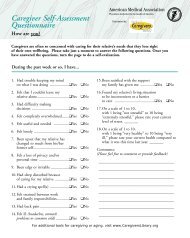MILES AWAY: - National Alliance for Caregiving
MILES AWAY: - National Alliance for Caregiving
MILES AWAY: - National Alliance for Caregiving
Create successful ePaper yourself
Turn your PDF publications into a flip-book with our unique Google optimized e-Paper software.
Executive Summary<br />
Family care from a distance is a fact of life <strong>for</strong> millions<br />
of Americans. Living at a distance from an<br />
aging parent or grandparent can make care provision<br />
a complex and difficult challenge. And, <strong>for</strong><br />
many of those who are caring at a distance, these<br />
challenges affect not only the personal activities<br />
of the care providers, but their work and career<br />
as well. In 2004, the MetLife Mature Market<br />
Institute and the <strong>National</strong> <strong>Alliance</strong> <strong>for</strong> <strong>Caregiving</strong><br />
undertook a survey of long-distance caregivers to<br />
examine these challenges. A sample of 1,130 longdistance<br />
care providers participated in an on-line<br />
survey conducted by Zogby International, an international<br />
polling and market research firm.<br />
KEY FINDINGS<br />
The <strong>Caregiving</strong> Situation<br />
Despite an average distance of 450 miles and<br />
7.23 hours of travel time one-way, long-distance<br />
caregivers reported substantial regular<br />
personal contact with the person they were<br />
helping; 51% reported visiting at least a few<br />
times a month.<br />
Nearly one-fourth (23%) of the long-distance<br />
caregivers reported they were the only or primary<br />
care provider.<br />
Nearly three-quarters of the respondents were<br />
helping their loved one with instrumental<br />
activities like transportation, shopping, managing<br />
finances or cooking and were spending 22<br />
hours a month on this help.<br />
Almost half reported that they were managing<br />
needed services and spending the equivalent of<br />
nearly one full day a week doing so.<br />
Long-distance caregivers most often depend<br />
upon a sibling who lives near the care recipient.<br />
Nearly 80% of these care providers were working<br />
either full or part-time.<br />
Effect on Work<br />
More than four in ten had to rearrange their<br />
work schedules in order to take care of their<br />
caregiving responsibilities, more than a third<br />
(36%) reported missing days of work, and 12%<br />
took a leave of absence.<br />
Both men and women were equally likely to<br />
have rearranged their work schedules, left early<br />
or came in late to work, taken an unpaid leave,<br />
or to have considered changing employers.<br />
Women were more likely than men to report<br />
that they missed days of work and/or moved<br />
from full-time work to part-time work.<br />
Financial Contribution<br />
Long-distance caregivers spend an average of<br />
$392 per month on travel and total out-ofpocket<br />
expenses.<br />
Distance is a factor in the total out-of-pocket<br />
expenses reported by respondents. Those who<br />
live between 1 and 3 hours away from the care<br />
recipient spent an average of $386 per month<br />
on travel and direct expenses <strong>for</strong> items needed<br />
by the care recipient; those who live more than<br />
3 hours away spent an average of $674 per<br />
month.<br />
For the relatively small group of respondents<br />
(nearly 10%) who also paid <strong>for</strong> services the<br />
care recipient needed, women reported spending<br />
on average $751 a month compared to men<br />
who spend an average of $490 a month.<br />
2









